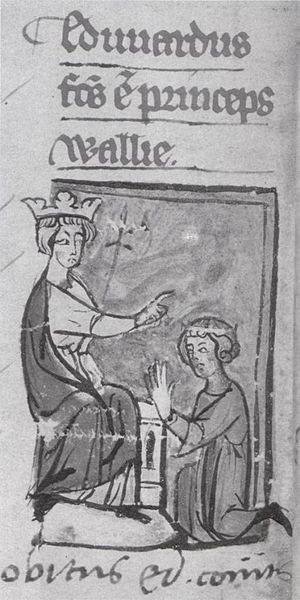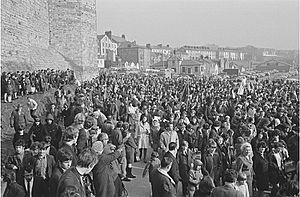Investiture of the prince of Wales facts for kids

The Prince of Wales is a special title. It is usually given to the person who is next in line to become the King or Queen of England or Britain. This person is called the "heir apparent." Sometimes, there is a special ceremony called an "investiture." During this ceremony, the Prince of Wales is officially given symbols of their new role. However, the title is actually made official through a special document from the monarch called "letters patent."
The last investiture ceremony happened in 1969. It was for Queen Elizabeth II's oldest son, who later became King Charles III. His son, William, Prince of Wales, does not plan to have an investiture. This is because there has been some disagreement in Wales about the title.
Contents
Early Welsh Princes

Long ago, there were native Welsh princes who ruled Wales. One famous prince was Llywelyn ap Gruffudd, also known as Llywelyn the Last. In 1282, he put his special crown, called a coronet, and other royal items with monks for safekeeping. Sadly, he was killed later that year. His coronet was taken and given to King Edward I of England. This showed that the independent Welsh state was completely taken over.
English and British Princes of Wales
The tradition of giving the title "Prince of Wales" to the heir to the English, and later British, throne started in 1301. King Edward I gave the title to his son, Edward of Caernarfon.
Royal Symbols
Princes of Wales have special crowns called coronets. Frederick, Prince of Wales, had a coronet made in 1728. We do not know if he ever wore it. But his son, George III, and grandson, George IV, both used it when they were Prince of Wales.
Later, Frederick's old coronet was replaced. A new one was made for George, Prince of Wales, who later became King George V. At his father's coronation in 1911, George V's son, Edward, wore this new coronet. Edward also wore it at his own public investiture ceremony. This event took place at Caernarfon Castle in Wales on 13 July 1911.
Edward, Who Became King Edward VIII
Edward became Prince of Wales on his 16th birthday. This was soon after his father, King George V, became king.
King George V was convinced by David Lloyd George, a Welsh politician, to bring back the investiture ceremony for Edward. The ceremony was made to look like a grand medieval event. It happened at Caernarfon Castle in North Wales. This royal event was meant to bring the country together. At the time, there was a lot of unrest and disagreement.
Edward briefly reigned as King Edward VIII in 1936. When he gave up his throne and left the country, he took the Coronet of George, Prince of Wales, with him. This was against the rules. Because that traditional coronet was not available, a new one was made. This new coronet was used for Prince Charles's investiture.
Charles, Who Became King Charles III
Charles, the son of Queen Elizabeth II, was made Prince of Wales and Earl of Chester in 1958. However, his official investiture ceremony did not happen until 1 July 1969. The ceremony was held at Caernarfon Castle.
Before his investiture, Prince Charles spent ten weeks learning about Welsh culture, history, and the Welsh language. He studied at the University College of Wales, Aberystwyth. During the ceremony, he spoke in both English and Welsh. He even gave his main speech in Welsh.
He said:
I, Charles, Prince of Wales, do become your liege man of life and limb and of earthly worship, and faith and truth I will bear unto thee, to live and die against all manner of folks.
In 2009 and 2019, the BBC showed a repeat of the original TV broadcast of Charles's investiture. This was to celebrate the 40th and 50th anniversaries of the event.
William, The Current Prince of Wales
William, the son of King Charles III, was made Prince of Wales on 9 September 2022. There are no plans for a formal investiture ceremony for him. Instead, the focus is on "deepening the trust and respect of the people of Wales."
Disagreement About Investitures
Leading up to Charles's investiture, there were protests. Many groups and people in Wales were against the ceremony. These included Dafydd Iwan, Edward Millward, and the Welsh Language Society. On the day of the investiture, some peaceful protesters were arrested.
Since Charles's investiture, other important groups and people in Wales have called for the title to end. These include Plaid Cymru, Republic, and famous people like Michael Sheen.
When Prince William was announced as Prince of Wales in September 2022, a petition was started. It asked to end the use of the title. It quickly received many signatures.
Public Opinion
People in Wales have different opinions about the Prince of Wales title and investitures.
A BBC Wales survey in 1999 found that most Welsh speakers wanted the Prince of Wales position to continue.
Another BBC survey in 2009 showed that more than half of the Welsh population wanted a similar public ceremony for Prince William.
A 2018 survey found that 57% of Welsh people supported the title continuing. However, fewer people (31%) supported having another investiture ceremony just like the one in 1969.
Surveys on Investiture Type
| Date(s) conducted | Polling organisation & client | Similar investiture to 1969 | Different investiture to 1969 | Oppose | Undecided |
|---|---|---|---|---|---|
| 20–22 September 2022 | YouGov / Barn Cymru | 19% | 30% | 34% | 17% |
| 2019 | ICM / BBC Wales | 41% | 20% | 30% | 9% |
| 2018 | YouGov / ITV Wales | 31% | 18% | 27% | 24% |
Surveys on Investiture Support
| Date(s) conducted | Polling organisation & client | Support | Oppose | Undecided | Lead | Note |
|---|---|---|---|---|---|---|
| 2021 | Beaufort Research / Western Mail | 61% | 26% | 13% | 35% | “When Prince Charles becomes King, would you like to see Prince William made the Prince of Wales at a public ceremony known as an investiture?” |
| 12–24 June 2009 | BBC | 58% | 30% | – | 28% | Non-standard oppose option: "not in favour of there being another public investiture ceremony similar to the type Prince Charles received at Caernarfon in 1969" |
| 1999 | Beaufort Research / BBC Wales | 72% | – | – | – | Non-standard: Welsh speakers only asked |



